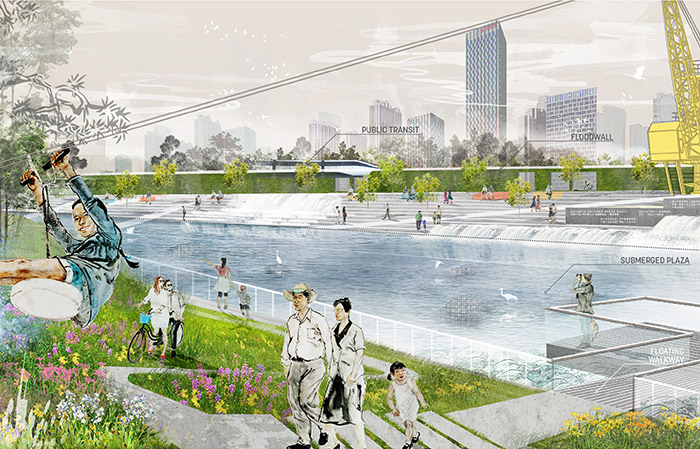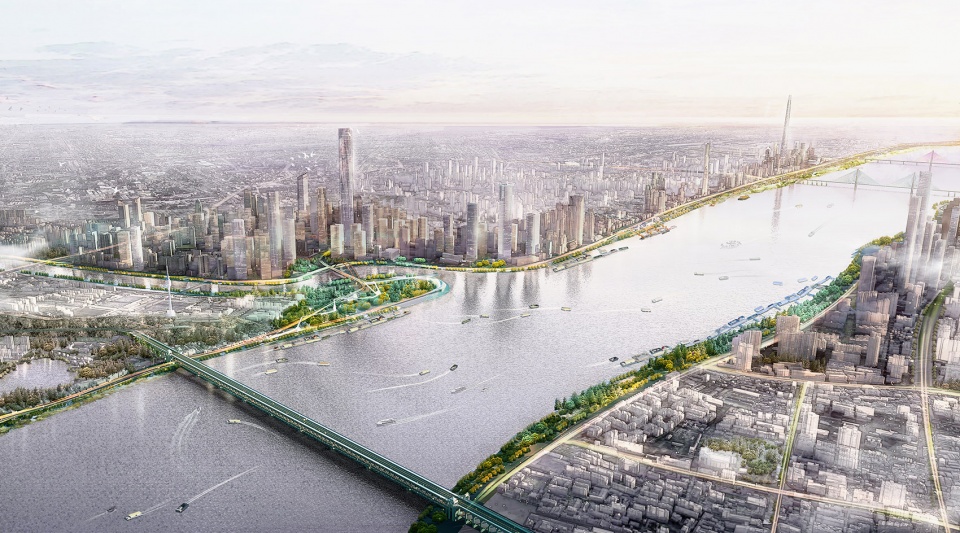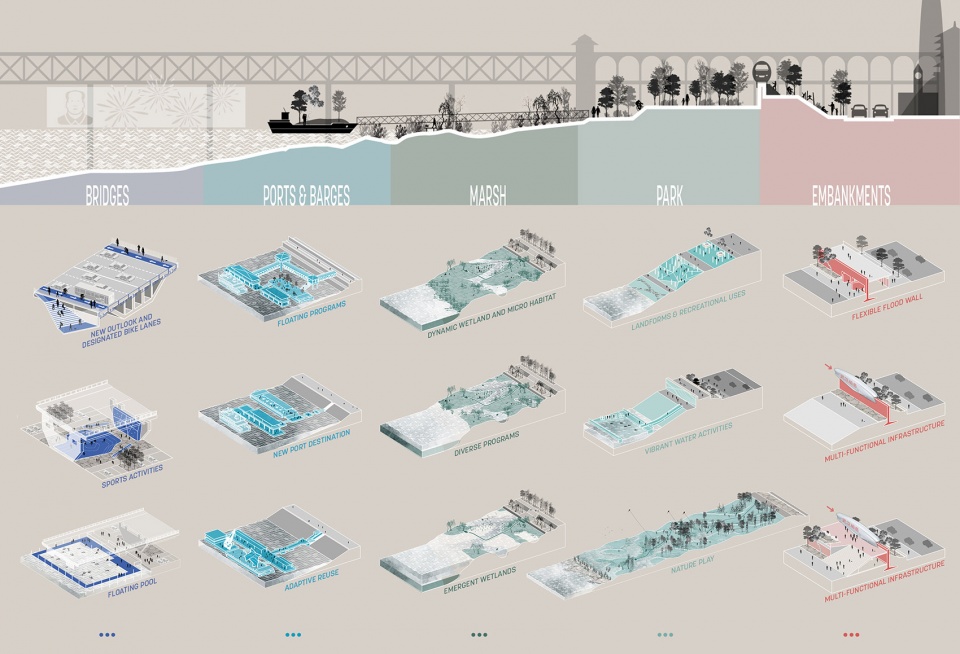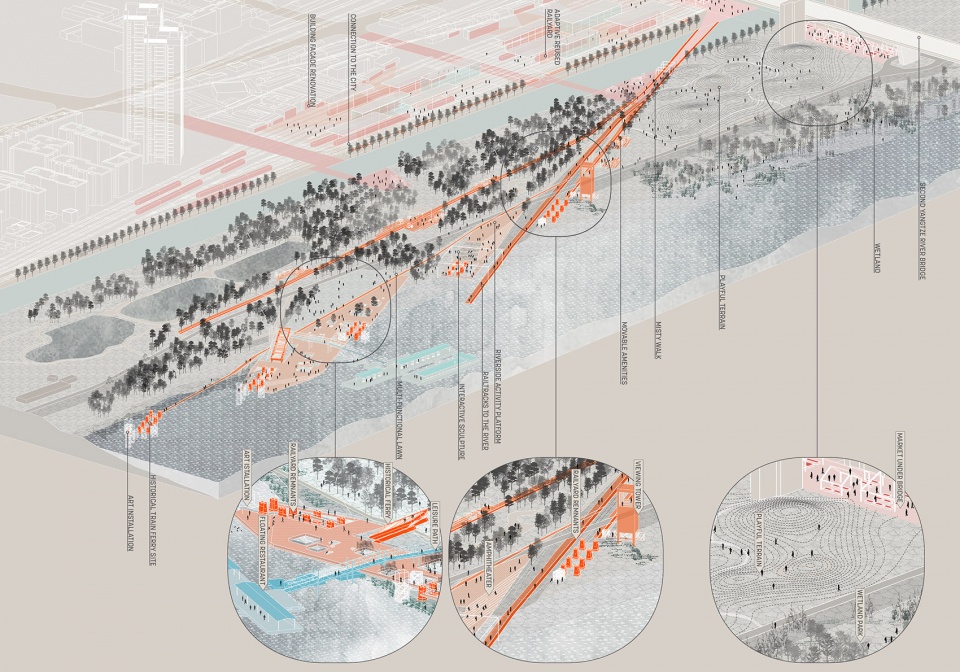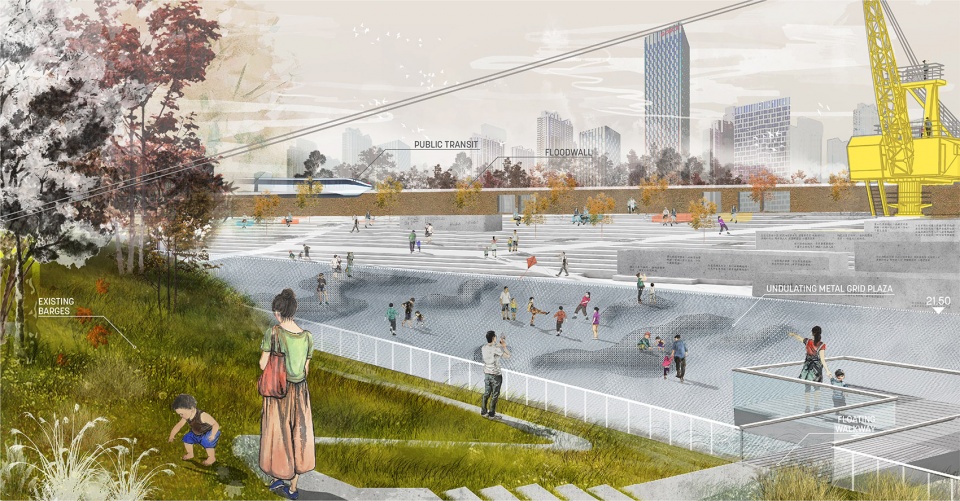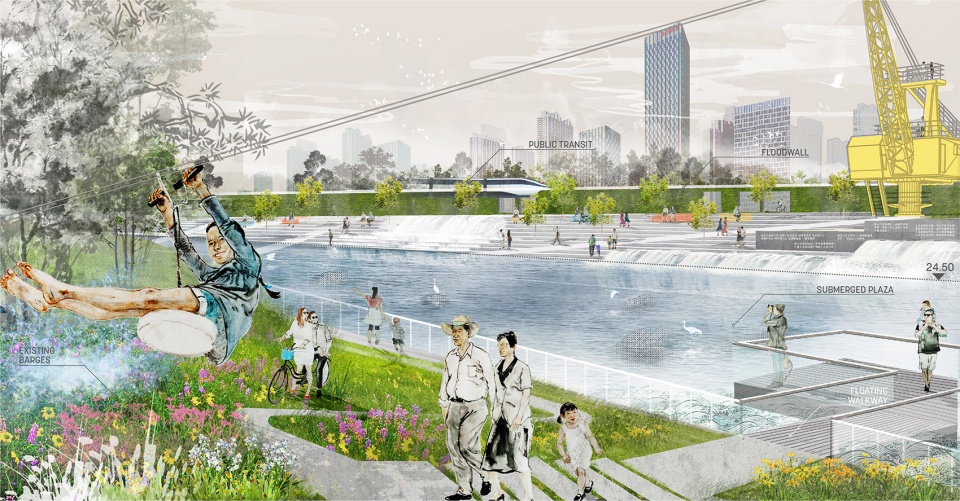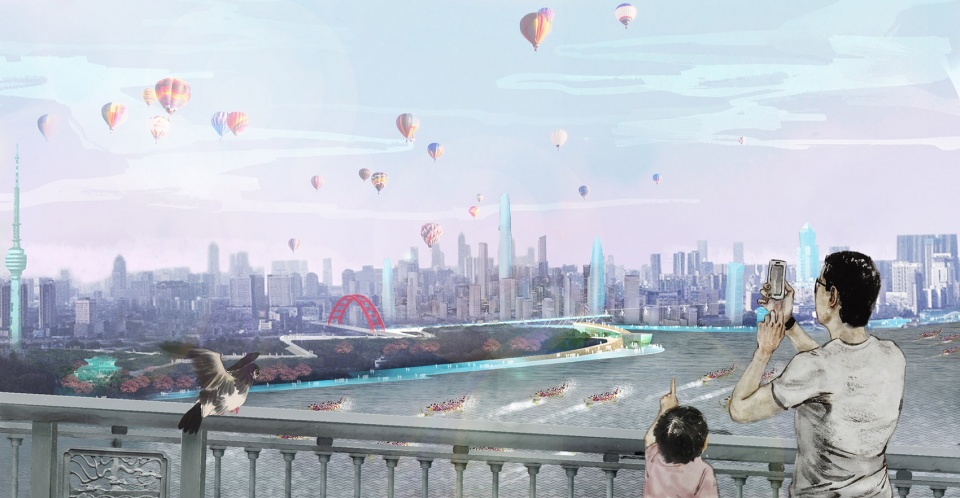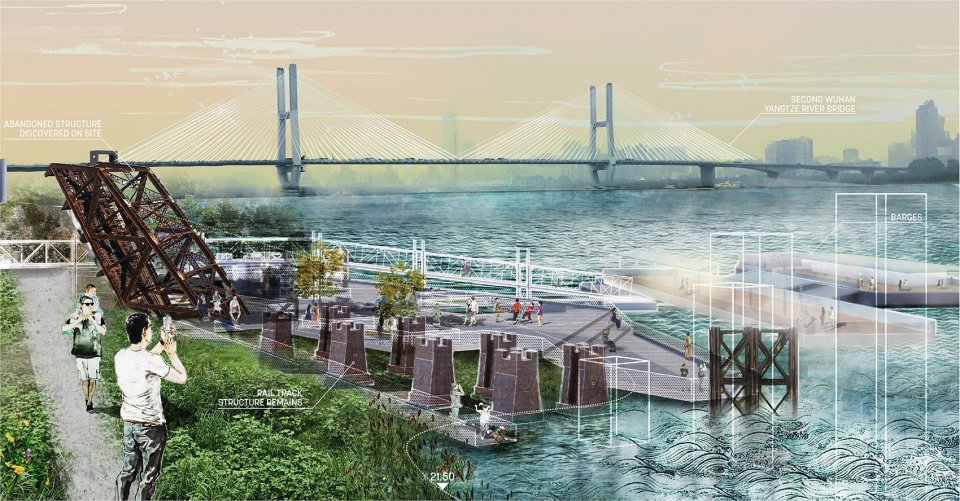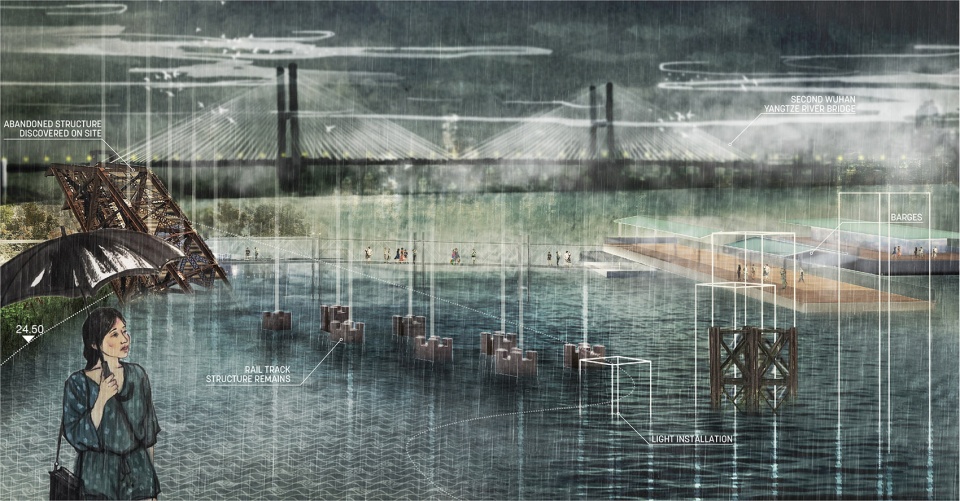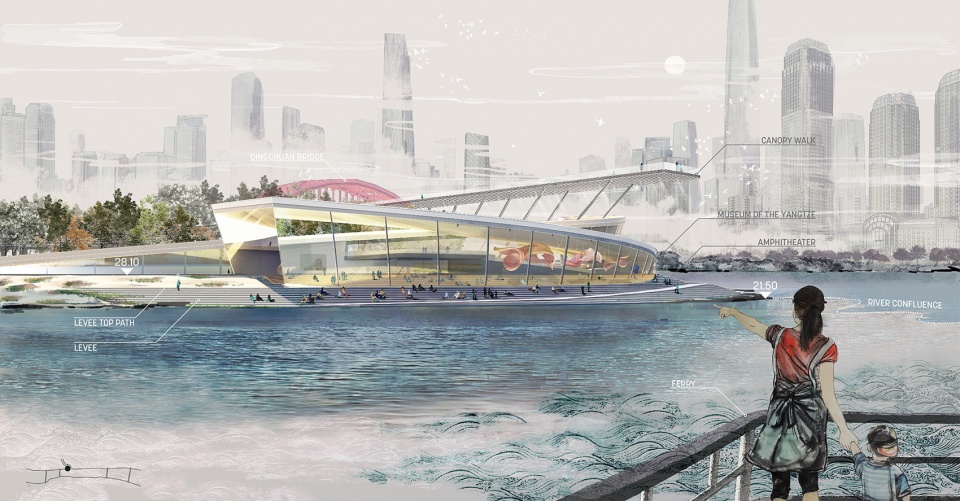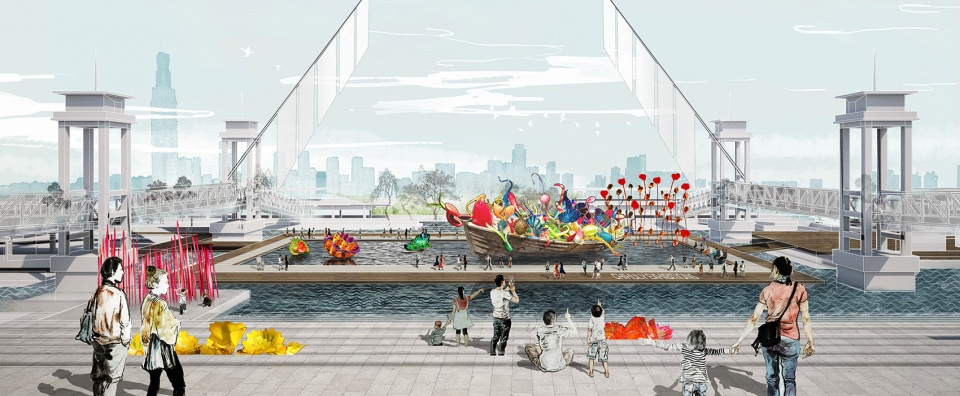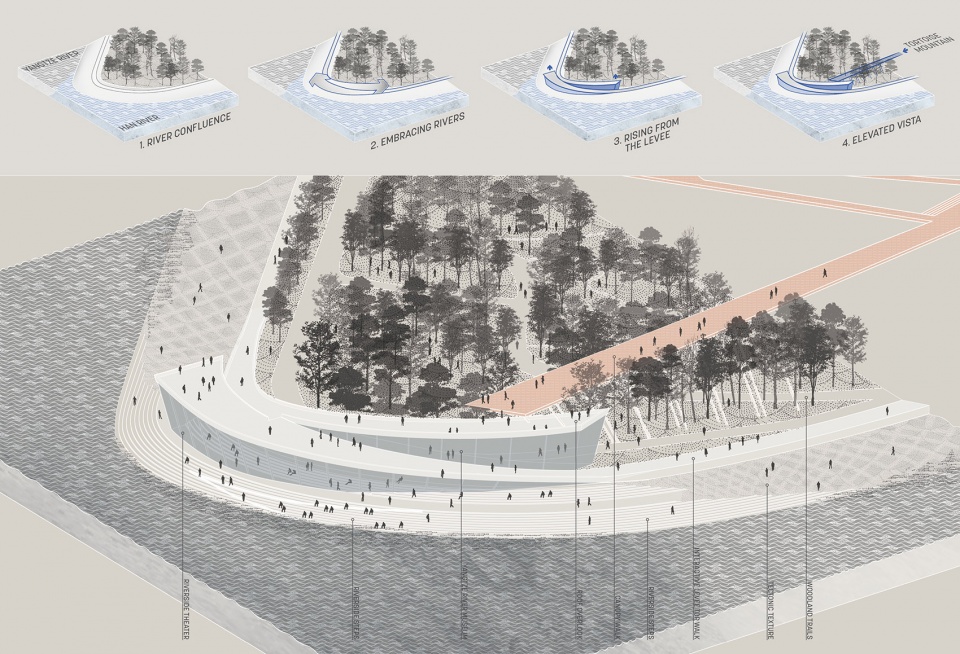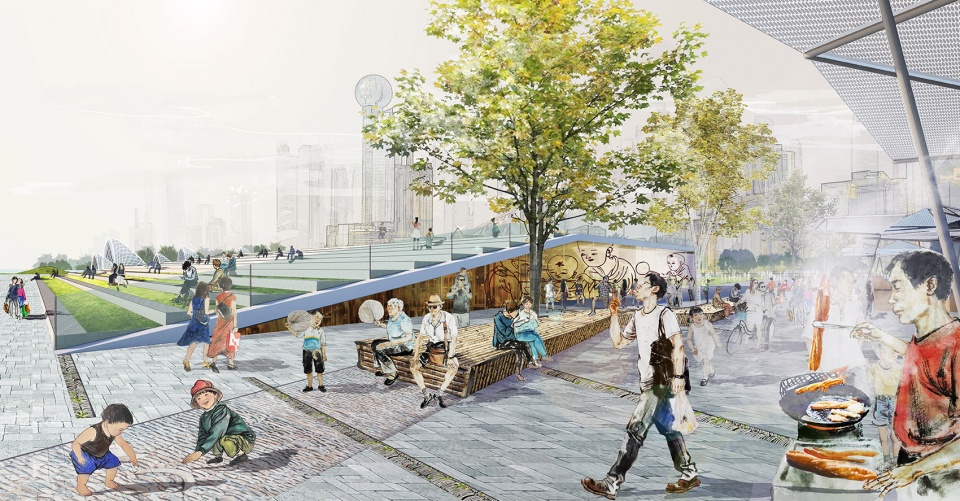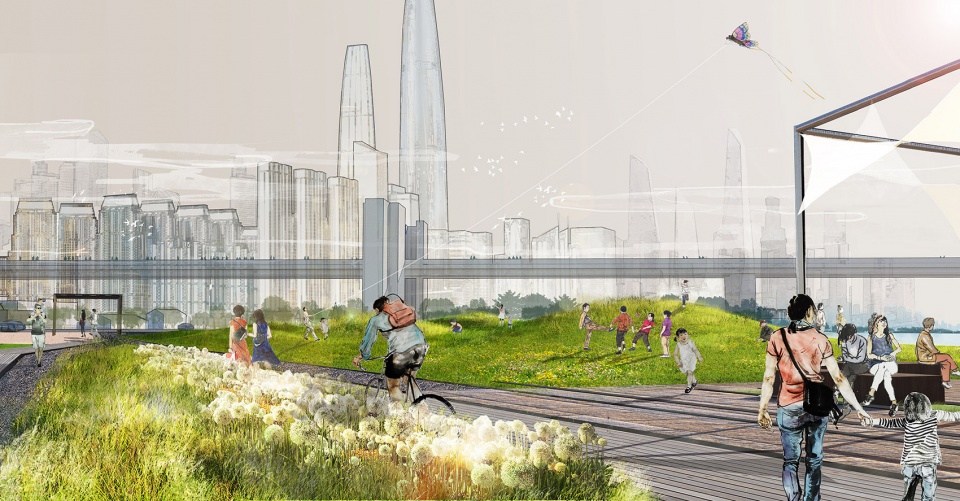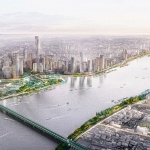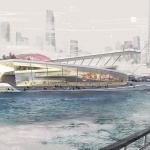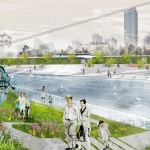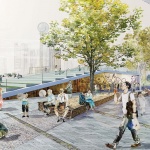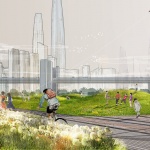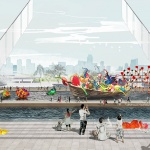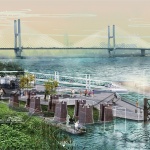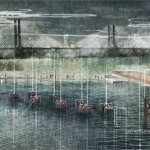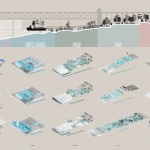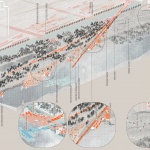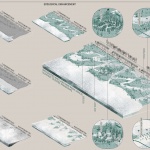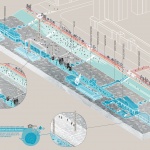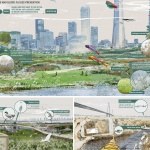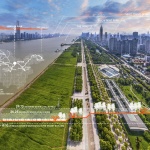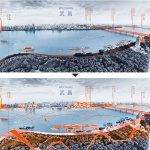非常感谢 Sasaki 将项目授权gooood发行。更多关于他们:Sasaki on gooood.
Appreciation towards Sasaki for providing the following description:
亚洲第一长河长江的流域覆盖了中国近五分之一的国土面积,被誉为中国的“母亲河”,孕育并滋养了中华文明,见证了数千年的经济发展和历史。然而,滔滔江水的威力不可低估,人们与长江的关系也日趋紧张。伴随着近年来史无前例的开发,尽管工程和科技加速进步,长江沿岸城市仍承受着严重的洪涝灾害。
The Yangtze is Asia’s longest river and drains one-fifth of China’s land area. Revered as the “mother river,” it has nurtured China’s history, culture, and economy since the dawn of civilization. This relationship between the people and the river has, in recent years, grown tense. Despite unprecedented advancements in engineering, all major cities on the Yangtze increasingly suffer from mounting flooding damage—demonstrating that the river is far from tamable.
▼长江边的武汉,the city of Wuhan alongside the Yangtze
中部重镇武汉与长江相依而生。长江赐予了这座城市广袤的肥沃土地,也为其带来了无尽的泛滥洪水。近年来,武汉广纳贤才,积极培育和扶植科技、教育和创新产业,推进城市发展,进而引发了土地开发和公共空间营造孰重孰轻的激烈争论。在历经了近一个世纪的工业化进程和城市扩张之后,武汉应该如何复兴和传承大河文化,是当下亟待思考和解决的重要课题。
Emerging because of its relationship with the Yangtze, central China’s largest city of Wuhan has coevolved with the river so symbiotically for the past 1,800 years that every milestone in its history has been tied to the river. Centuries of floods created fertile land for the early settlers, and high water safeguarded the birth of the city. As Wuhan has emerged as one of China’s hotbeds for technology, education, and innovation, land prices have soared and the city faces rising conflicts between development pressures and public demand for open space. It is striving to explore new ways of embracing the river after nearly a century of industrial exploitations and urban expansion.
▼总平面示意图,the illustrative plan
武汉的大河文化源远流长。武汉长江主轴滨水公园立足弘扬大河文化,以解决频发的洪涝灾害为主要切入点,融合古往今来城市与江水共生所积累的生活智慧,利用季节性水位变化营造活跃的空间体验,同时培育丰富多样的区域生态。
▼设计概念分析图,concept diagram
Wuhan’s Yangtze Riverfront Park leverages the river’s dynamic flooding to nurture a rich regional ecology, reinforce traditional wisdom and the local identity of living with an ever-changing river, and creates a dynamic recreational experience which is acutely attuned to the seasonal rise and fall of the Yangtze’s waters. This “river culture” is so deeply embedded in Wuhan that today people still frequent the riverfront parks even when they are flooded—enjoying the rare excitement of such intimate contact with the water. The design of the park celebrates this strong river culture and leverages frequent flooding events as a vital driver of placemaking strategies. Much of the programming along the river is designed to celebrate the river’s spontaneity and incorporate its flooding as an essential element of the ever-changing landscape.
▼滨水公园重要节点分析图,the diagram of the important nodes of the riverfront park
沿河的滩涂地为维持区域生态多样性提供了重要保障。然而长江上游兴起的水利工程,使得河道内沉积物通量大幅减少,进而引发滩涂地迅速流失,严重影响了区域的生态多样性。基于对滩涂地现状的分析,设计团队对河道进行策略性地疏浚和地形处理,营造多样的微环境,进而促进湿地生态系统多样性。舒缓的地形变化与季节性水位变化相结合,在不同类型湿地及春池等多种场所类型中,培育了丰富多样的植物群落。“四时之景不同,而乐亦无穷也。”
The river’s mudflats continue to play a critical role in supporting biodiversity and delivering crucial ecosystem services, but the sediment flux of the Yangtze River has dropped tremendously due to numerous upstream hydrological projects along the river. The rapid disappearance of these mudflats places regional biodiversity in jeopardy. Through strategic dredging and grading, the design creates heterogeneous microenvironments that host a wide variety of distinct wetland ecosystems in the mudflats. Nuanced topography, coupled with the river’s frequent water level fluctuations, enable complex plant communities to grow. From emergent marshlands to vernal pools, these typologies create an evolving landscape character throughout the year.
▼生态多样性的改善措施,the ecological enhancement
涝季时,一系列蜿蜒的次级溪流流入滩涂地,为水生动植物提供丰富的栖地,也为游客,尤其是皮划艇爱好者,提供了静谧怡人的乐水空间。在旱季,游客可踏溪床穿梭漫游于浓密高草丛中,体验独特野趣。
▼分析图 – 水位相关设计, diagram of the design related to the water level
A series of sinuous secondary streams are graded to emerge in the mudflats during mid-high water levels, and provide alternative passages for aquatic wildlife, as well as safe corridors for kayaking. This strategy creates a tranquil experience amid tall marsh grasses, even when the Yangtze’s waters roar. During dry months, these stream beds function as informal pathways for visitors to explore, slicing through the dense grasses.
▼旱季时,游客们在下沉广场和河道上上行走嬉戏,stream beds and plazas function as informal pathways for visitors to explore during dry months
▼雨季时,河道和下沉广场被水淹没,形成水景,stream beds and plazas are submerged by water to form a water view during mid-high water levels
▼滨水公园局部,为游客提供了乐水空间,partial view of the riverfront park, providing safe corridors for kayaking
广阔的湿地滩涂内,供龟类和两栖动物歇憩的朽木,供水底培育鱼类的水下丛林,供水禽筑巢歇脚的树桩等景观元素为野生动物创造了舒适友好的栖息环境。隐匿于树林中的观鸟台,则为野生动物爱好者提供了绝佳的观测场所。团队进一步研究明确了长江流域主要滩涂野生物种的栖息地斑块尺寸,以避免其被人类活动侵入。在洪涝期,滩涂地内的活动场地重新成为河流的一部分,并行使其作为野生动物的栖息地的生态功能。
Alongside logs for turtles to loaf on and submerged fish structures, waterfowl nesting platforms are installed in the open marsh. Discreet birding stations within the tree groves offer viewing opportunities for wildlife enthusiasts. Recreational spaces are arranged based on careful calculations of the dispersing distances for the key wildlife species in the river basin such that they do not intrude into the primary habitats. During floods, the recreational fields in the mudflats are temporarily returned to the river and repopulated by fish and waterfowl.
▼湿地滩涂内的动植物多样性,diverse plant communities and blood-flukes prevention
除了生态方面的考量,设计也充分呈现了武汉丰富的工业发展史,将一系列具有丰富历史内涵的地标纳入滨水公园中。基地内占地面积较大且废弃多年的车辆段,货运火车站码头遗址等,都作为主要设计节点进行展现。在保留场所记忆的同时,设计也为游客创造了丰富多样的亲水体验。江上多组相互连接的趸船上设置了餐厅、画廊以及社区花园等活动区。趸船随水位涨落而上下浮动,充分体现了与水共生的场所体验,同时呈现了一幅欣欣向荣的滨水文化新画卷。
Wuhan’s rich industrial history is also celebrated, with historical landmarks highlighted throughout in the riverfront park. Though largely abandoned, the site’s massive railyards and remnants of freight train ferry terminals have a strong visual presence. This heavy-duty infrastructure offers engaging platforms for park visitors to more intimately experience the river, while a series of barges are connected to form a floating promenade. This promenade rises and falls with the river, and delineates a uniquely dynamic space in between. The design of the riverfront park repurposes these industrial relics as vibrant waterfront hubs of new cultural and recreational uses, including floating plazas, restaurants, galleries, and even a floating community garden.
▼滨水公园局部,废弃的工业遗址被作为主要设计节点进行展现,partial view of the riverfront park, the abandoned historical landmarks are highlighted throughout in the riverfront park
▼滨水公园局部,一系列可用于公共活动的趸船形成一个漂浮长廊,partial view of the riverfront park, a series of barges that can serve as public spaces are connected to form a floating promenade
在南岸嘴标志性的“江汉之心”,游客可纵览长江汉江交汇的壮丽图景和一水两色的奇观。 “长江文明之心”博物馆于长江大堤拔地而起,活跃的江岸景象和蓬勃的城市天际线在此一览无余。
At the iconic “Tip of China”—the peninsula at the scenic confluence of the Yangtze the Han rivers—the distinct color of the water of the two rivers clash abruptly with a clearly visible boundary in the middle of the Yangtze. Here, the Museum of the Yangtze rises from the levees and offers an uninterrupted panorama of Wuhan’s waterfront and burgeoning skyline.
▼滨水公园中的博物馆,the museum in the riverfront park
▼滨水公园中的科技博物馆,the science museum in the riverfront park
透过线上意见征集活动,广大巿民对设计方案表达了热烈支持,也就武汉长江主轴滨水区的未来发展方向取得了广泛共识。在整个项目过程当中,设计团队与甲方合作整合了逾65, 000条公众意见,有效地推动了设计的核心概念和优化。同时,当地民间团体组识了一系列公众探讨及基地调研活动,积极推动了滨江区域景观管理的公共参与性。当地青少年和儿童也参与到基地调研活动中来,并用画笔表达了他们对滨水公园的期冀。武汉长江主轴滨水公园总体规划以公众参与为基础,缔造多元共生,生态和谐 的滨水空间,复兴和传承大河文化,以城江新韵展现武汉人民世代以来与江共存的独特哲学。
▼滨水公园江边步道生成过程,the generation process of the paths alongside the river
A web-based outreach effort generated fruitful public support of the design, and consensus on the future of Wuhan’s waterfront. Throughout the design process, over 65,000 public comments were collected, helping to inform design various iterations. Local civic groups also organized a series of public meetings and site tours to promote stewardship of the river’s public landscapes. Local youth were also invited to portray their vision for the waterfront park at an event on site. Built upon a strong consensus from the public engagement, the master plan for the Wuhan Yangtze Riverfront Park creates a socially inclusive and ecologically meaningful waterfront with a strong cultural identity that embraces the Wuhan’s unique philosophy derived from centuries of living alongside a dynamic river.
▼滨水公园的步道和阶梯式休息空间,the paths and stepped rest area in the riverfront park
▼江边的步道系统,the path system alongside the Yangtze
项目名称:武汉长江主轴滨水公园
项目位置:中国武汉市
业主名称:武汉市国土资源和规划局
现况:总体规划设计於2018年完成
规模:503公顷
服务范围:规划及城市设计、景观建筑
Project name: Wuhan Yangtze Riverfront Park
Project location: Wuhan, China
Client name: Wuhan Land Resources and Planning Bureau
Size: 503 hectares
Status: Masterplan Completed in 2018
Services: Planning and Urban Design, Landscape Architecture
More: Sasaki 更多关于他们:Sasaki on gooood.
